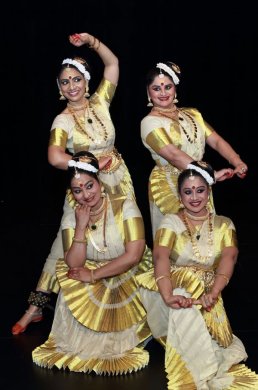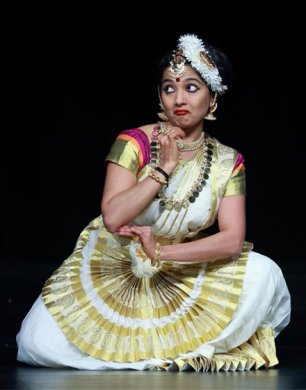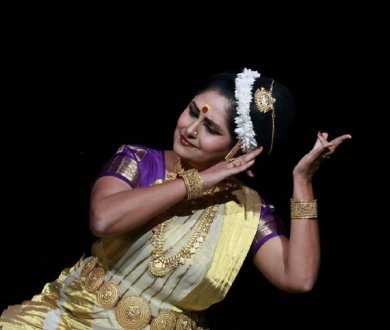
|   |

|   |
Raagamayi: Devotion in dance - Minnie Homchowdhury e-mail: Mhomchowdhury@hotmail.com November 25, 2018 If dance is the hidden language of the soul, of the body, and love is the language of the universe, then together they make a dynamic combination to reveal the inner landscapes of the mind. The Mohiniattam dance repertoire 'Raagamayi' presented by Dr. Sunanda Nair and her team, on November 11, 2018 at the Weiss High School in Austin, TX, was a perfect platform to witness the magic of dance and explorations of love in its many forms. Raagamayi loosely means "one who is committed in love or devotion". The dancers used graceful, swaying movements of the Mohiniattam dance form of Kerala to create a vision of the gently swaying palm trees, the undulating ocean waves and the lush, scenic landscapes native to the state of Kerala, to tell stories of love that ranged from a mother's love for her child, a lovelorn heroine's longing for her lover, and finally a devotee's spiritual, all-encompassing love for her maker.  Sitting: Sarita Warrier & Arathi Remesh; Standing: Suja Pillai & Divya Shanker The program began with a traditional invocation "Paripaahi Ganaadhipa" performed with sparkling energy by Aathira Vijayakumar and Mamata Vasantkumar, two of Sunanda Nair's most promising young shishyas.This moved seamlessly into the 'Mukhachalam,' a pure dance item, executed expertly by her senior shishyas, Arathi Remesh, Divya Shanker, Sarita Warrier and Suja Pillai, who displayed mastery of the Mohiniattam adavus or step patterns throughout this dance. The next piece was a solo padam "Omanathingal," essentially a lullaby put to poetry by Irayiman Thampi for Maharaja Swati Thirunal. Dancer Gayathri Prasanth's charming portrayal of a doting mother, who sees the light of divinity in her child's pranks, was accentuated by the lilting melody of Kalamandalam M.S. Gireesan's rendition of the padam in ragam Navarasam.  Gayathri Prasanth From a charming lullaby, we swiftly moved into a world of complex, emotional expressions in the 'Ashtanayika.' Sunanda Nair's shishyas once again held the audience's attention as they navigated the intricacies of a maze of emotions through a montage of ragas, depicting the Ashtanayikas as envisioned by Dr. Kanak Rele as the following eight heroines. Vasakasajjita, as one who eagerly awaits a union with her lover, Arathi Remesh took us into her joyous mood as she prepares her heart and home. As Virahotkanthita, the separated one, Sarita Warrier convincingly played the sorrowful heroine who realizes that despite her preparations, her lover has not arrived. Svadhinabhartruka is the independent and confident heroine. This is an interesting character portrayal of one who is in love, but in command of her circumstances and Divya Shankar showed the quiet, control of the heroine who cannot be easily fooled. In Kalahantarita, the inconsolable one, the nayika becomes quarrelsome and refuses to be consoled. The feelings of disapproval were subtly and aptly portrayed by Suja Pillai. As Khandita, Arathi returned to demonstrate the seething anger and disappointment of the heroine who catches the hero in a compromising situation. In Vipralabdha, the dejectedness yet hopefulness of this personality are contradictions which Sarita returned to show through changing expressions. As Proshitabhartruka, Divya returned to show her abhinaya of the heartbreaking sadness of a heroine, whose lover is leaving on a long journey, filling her heart with woe. Finally as Abhisarika, there is excitement, despair and a strange boldness in Suja's painting of this nayika, who abandons all care in search of her lover. Sunanda Nair took the stage for the second half of the evening's performance and it was a visual treat for the audiences to see what she has achieved with her mastery of the Mohiniattam dance form. Added to that, is her multi-disciplinary training in several of the Kerala arts as well as Bharatanatyam and the ancient texts. Through her work she pays tribute to the doyen of Mohiniattam, Dr. Kanak Rele, as well as her other notable gurus - Kalamandalam Krishnankutty Warrier, Gurus Deepak Mazumdar, Mahalingam Pillai, Kadirvelu Pillai, Kalamandalam Sivan Namboodiri, Kalamandalam Gopi and Mattannur Sankarankutty. So vast is her dance journey that it has recently been chronicled by national award winning film director Vinod Mankara in a documentary 'Laasyam, The World of Sunanda Nair', which the audience was treated to a sneak peek trailer of, leaving us eagerly waiting for its full worldwide theatrical release. 
Sunanda Nair
Beginning with "Oru Magal," an ancient Tamil 'aham' poem, Sunanda played out the story of a loving mother and her young daughter and how their close-knit relationship falls apart when the daughter chooses to elope with a stranger from far-off lands. The palpable sorrow of the mother portrayed so realistically by Sunanda, who beseeches neighbors and friends despairingly, pulled at the heartstrings of every parent present. She expertly moved on to the next piece of the evening which traces the life of Amba and the suffering she endures at the hands of Bheeshma. Amba is reborn as Shikandi to wreak revenge on her enemy -we see glimpses of her Kathakali expressions woven intricately into the tapestry of a traditional Mohiniattam abhinaya filled piece. Her gestures and movements are at times strong and decisive to show the manly Shikandi, while elsewhere soft and graceful to depict Amba, both existing in the same form. An intelligent use of the traditional musical ensemble of Mohiniattam with Pallassana Sreejith Marar on edakka, violin by Manu Narayanan, and mridangam by P. Janardhana Rao, in conjunction with the melodious vocal support of Kalamandalam M. S. Gireesan, provided an other worldly experience for the audience where the drama of birth and rebirth, love and revenge were acted out through transitions of characters and movement styles by Sunanda Nair with incomparable expertise. The piece-de-resistance of the evening was 'Kubja,' her final presentation of the evening. This is an age-old story of the hunchbacked servant Kubja, who prays to Krishna to be released from the bondage of her wretched life. The pinnacle of the piece is when Krishna grants his faithful devotee the gift of salvation by freeing her soul and the crescendo rises in the beautiful raga Yadukulakamboji, as the soul of the devotee finds its maker. The audience was lifted to the heights of a devotee in that moment. Finally, the Mangalam, with all shishyas joining their guru on stage, concluded this enchanting evening replete with beautiful classical music and dance. Raagamayi left Austin audiences entranced and mesmerized in Dr. Sunanda Nair's world of Mohiniattam. |